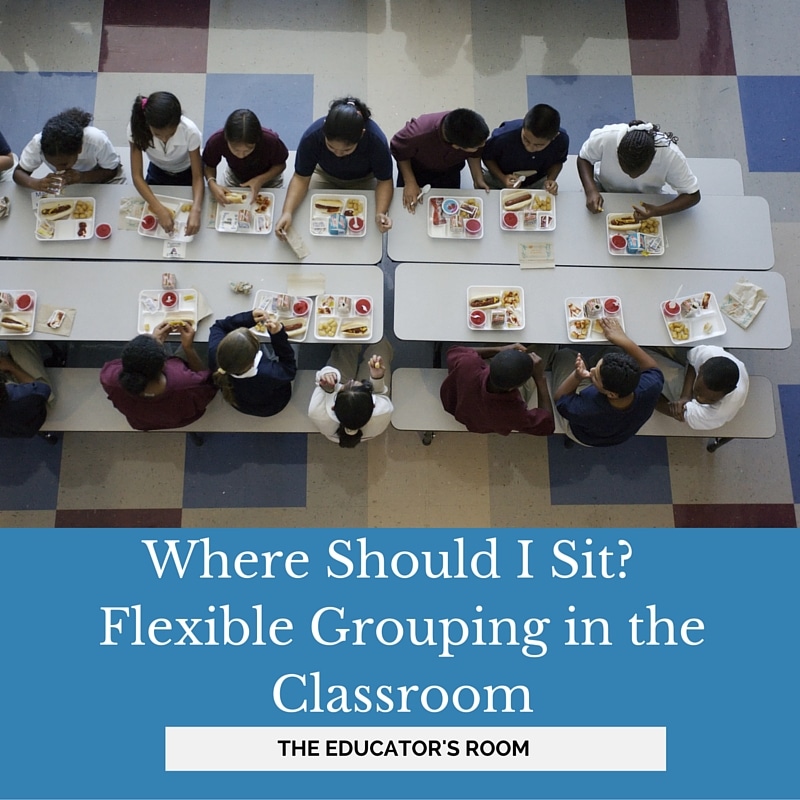I remember the old cartoons and movies that depicted classrooms. The students were all sitting in rows of desks, and the teacher’s desk was front and center in front of the chalkboard. My, how times have changed. Today, our classrooms look different, and students learn differently. There are many ways to arrange classrooms and group students for optimal learning especially using flexible grouping. Here are a few ideas you can try in your classroom.
Depending on the age you teach, the degree of selecting seating arrangements will be on a sliding scale from teacher selection to student selection. At the open house (our district runs this before school starts for students to come to meet their teacher, bring their supplies, etc.) I have my desks arranged into cooperative learning groups and let the students select where to sit.
This seating chart may last a few days or a few weeks, depending on the learning environment created. However, I feel it is important to allow students to sit somewhere they are comfortable. If I can alleviate anxiety on the first day of school by simply allowing students to select their seats, it will create a more positive classroom environment. If learning is not stopped, the student will get to sit here for a few days.
Fundamentals of Classroom Seating
There are a few fundamentals to consider when setting your classroom seating. Do you have students with glasses, hearing aids, or other needs for sitting at the front? Do you have students with para support who will need to be seated on the end for adults to sit close to them for assistance? Often times arranging desks feels like a very complicated jigsaw puzzle. As you teach your students, it can be done fairly painlessly throughout the year. I always know my signal to change desks is when student behavior becomes an issue. Talking, not completing work and activities taking longer than I had planned are good signals it is time to change things up a bit.
Traditional Seating Arrangements
A traditional seating arrangement is placing desks in rows. Sitting students in rows allows all students to see the front of the room and face the teacher. This method works well if you are in a classroom where presentations, interactive lessons on a projector or Smartboard, and lectures are the primary instructional methods.
This method allows for pair and share, be sure to set students in even numbers in the rows so partners work out. If you are using this seating arrangement, make sure student desks are touching and not spread out (think back to Charlie Brown) to increase student interaction and, therefore, increase learning.
Cooperative Learning
Many elementary classrooms use cooperative learning, which is easily facilitated by placing students’ desks in groups. Seating students together in pods of four or six will allow for group work and increased communication. This works well when projects, labs, cooperative group work, the jigsaw method, or activities are used as the primary instructional method. Be sure students are sitting so they can see the board when someone is presenting or lecturing. You do not want to place half of the students with their backs to the front of the room. Depending on the make-up of your classroom, it is usually best to group students into varying abilities and learning styles. This allows for groups to use each other’s strengths when working. If you set students of likeability or learning style together, be sure to have a purpose in this grouping.
Classroom Layout
Beyond the student’s desks, you should consider the classroom layout for comfort and ease and invite learning and exploration. The teacher’s desk has moved from its prominent place, front and center, to a side area for a workspace or office. Other areas of the room include books, art supplies, and manipulatives needed for student work. These areas should be organized for students to use and return items. Think about 25 students accessing these areas at once; having them on open shelves in the middle of the wall is best instead of tucked into a corner. You may also have carpets or learning center needs. Again, think about the number of students who will need to access this area at once and arrange the area for ease of flow.
You don’t need an engineering degree to create a seating chart for your classroom. Think about your teaching style and your student’s needs. Arrange students so they can learn from each other and complete the activities, projects, labs, assignments, and readings needed for the curriculum in your classroom. Most importantly, don’t be afraid to move things around when something is not working.






Nice! Very comprehensive and retrospective. A must read for all new teachers…